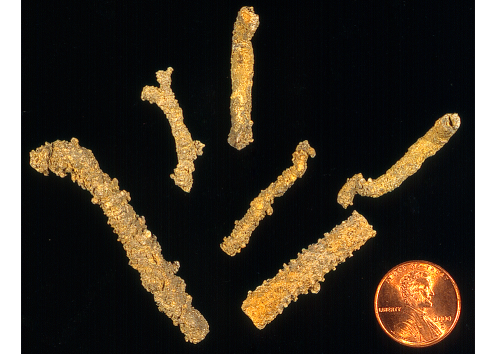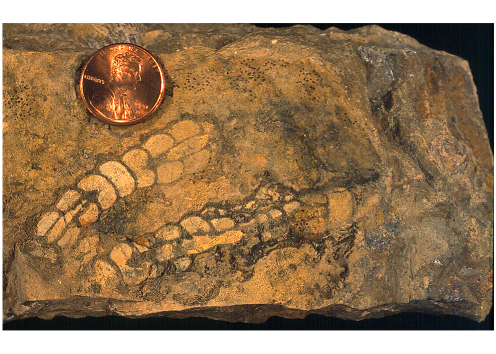Sponges

Sponges, members of the phylum Porifera, are one of the simplest multicellular animals living today. They're also among the oldest, with a fossil record extending back to the last part of the Precambrian, about 550 million years ago. Sponge fossils occur in rocks all over the world. In Kansas, fossil sponges can be found in the Pennsylvanian and Permian rocks in the eastern part of the state.
Unlike most larger multicellular animals, sponges lack tissues, organs, and respiratory or circulatory systems. Instead, they rely on specialized cells to perform the different functions necessary for survival. Some cells, for example, equipped with flexible tails, or flagella, create one-directional currents that draw nutrient- and oxygen-bearing water into the sponge and help eliminate waste products. Other cells perform tasks associated with support, reproduction, or protection.
Sponges come in many different colors, shapes, and sizes. Some sponges have irregular shapes, or look like encrusting sheets, while others take the form of mounds, or tubes, or even a series of spheres reminiscent of beads on a necklace. They range in size from 1 cm to more than 2 meters. Many of the differences in size and shape are due to environmental factors, such as temperature, salinity, turbulence, and the amount of sediment in the water. This means that members of a single sponge species may look very different from each other.
The approximately 5,000 species of living sponges dwell at various depths in the world's oceans. Sponges from the Paleozoic and earliest Mesozoic, however, lived mostly in shallow water and were, at times, important reef builders.
Even though sponges have a long fossil record, they are not common fossils. This is partly due to their relatively delicate skeletons and to the low-sediment environments that ancient sponges seemed to prefer (which precluded the quick burial necessary for preservation). Most fossil sponges are known solely from mineralized spicules and are differentiated by the chemical composition of these spicules. Sponges are relatively inconspicuous fossils in the Pennsylvanian and Permian rocks of eastern Kansas: for example, chaetetid sponges are found in Labette, Crawford, Bourbon, and Neosho counties. They are, however, locally common in the Pennsylvanian Hickory Creek Shale Member of the Plattsburg Limestone in Wilson County and the Hartford Limestone Member of the Topeka Limestone, in Greenwood County.
Stratigraphic Range: Upper Precambrian to Holocene.
Taxonomic Classification: Sponges belong to the Kingdom Animalia, Phylum Porifera. The phylum is divided into several classes based on the composition of the skeleton: the classes Demospongea, Hexactinellida, and Calcarea.
Text and photos from Windows to the Past: A Guidebook to Common Invertebrate Fossils of Kansas, Kansas Geological Survey Educational Series 16.
Sources
Boardman, R. S., Cheetham, A. H., and Rowell, A. J., eds., Fossil Invertebrates: Boston, Blackwell Scientific Publications, 713 p.
Clarkson, E. N. K., 1979, Invertebrate Palaeontology and Evolution, 3rd Edition: London, Chapman and Hall, 434 p.
Doyle, P., 1996, Understanding Fossils—An Introduction to Invertebrate Paleontology: Chichester, Wiley, 409 p.
Gehling, J. G., and Rigby, J. K., 1996, Long expected sponges from the Neoproterozoic Ediacara fauna of South Australia: Journal of Paleontology, v. 70, no. 2, p. 185-195.
Rigby, J. K., 1987, Phylum Porifera; in, Fossil Invertebrates, R. S. Boardman, A. H. Cheetham, and A. J. Rowell, eds.: Boston, Blackwell Scientific Publications, p. 116-139.


